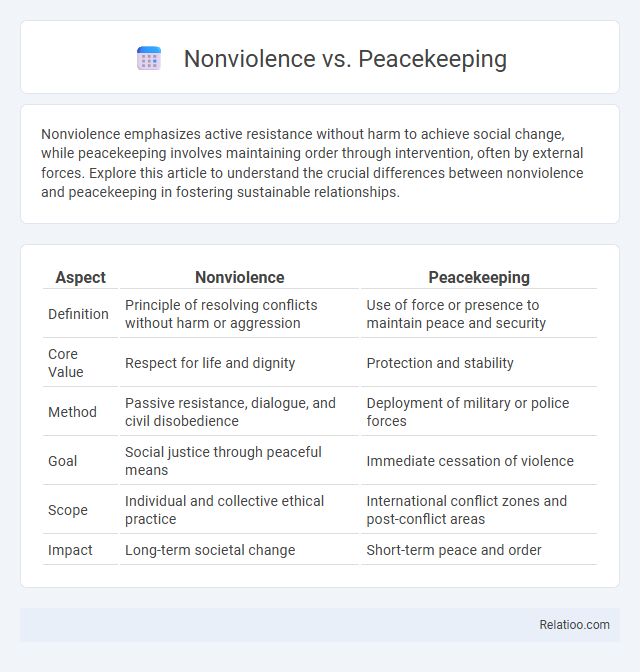Nonviolence emphasizes active resistance without harm to achieve social change, while peacekeeping involves maintaining order through intervention, often by external forces. Explore this article to understand the crucial differences between nonviolence and peacekeeping in fostering sustainable relationships.
Table of Comparison
| Aspect | Nonviolence | Peacekeeping |
|---|---|---|
| Definition | Principle of resolving conflicts without harm or aggression | Use of force or presence to maintain peace and security |
| Core Value | Respect for life and dignity | Protection and stability |
| Method | Passive resistance, dialogue, and civil disobedience | Deployment of military or police forces |
| Goal | Social justice through peaceful means | Immediate cessation of violence |
| Scope | Individual and collective ethical practice | International conflict zones and post-conflict areas |
| Impact | Long-term societal change | Short-term peace and order |
Understanding Nonviolence: Principles and Practices
Nonviolence is a principle-centered approach that emphasizes resolving conflicts through empathy, dialogue, and peaceful resistance without physical aggression or coercion. Peacekeeping often involves external forces maintaining order by monitoring ceasefires and protecting civilians, sometimes using force if necessary, which contrasts with nonviolence's strict commitment to abstaining from violence. Your understanding of nonviolence improves by embracing its core practices, such as active nonviolent protest, conflict transformation, and fostering mutual respect to achieve sustainable social change.
What is Peacekeeping? Definitions and Key Objectives
Peacekeeping refers to the deployment of international forces or personnel to maintain or restore peace in conflict zones, often under the mandate of the United Nations. Key objectives include monitoring ceasefires, protecting civilians, supporting the implementation of peace agreements, and facilitating political processes that lead to sustainable peace. Unlike nonviolence, which emphasizes active resistance without force, peacekeeping operates through a combination of diplomatic, military, and humanitarian efforts to prevent escalation and ensure stability.
Historical Roots of Nonviolence Movements
Nonviolence, deeply rooted in ancient philosophies such as Jainism and teachings of Mahatma Gandhi, emphasizes moral resistance without physical aggression. Peacekeeping, often associated with modern international efforts like United Nations missions, focuses on maintaining ceasefires and preventing conflict through external intervention. Understanding your role in these frameworks helps appreciate how nonviolence shapes grassroots movements, while peacekeeping relies on structured enforcement to sustain order.
The Evolution of International Peacekeeping
International peacekeeping has evolved from traditional military interventions to incorporating nonviolent strategies that prioritize conflict resolution without force. Nonviolence emphasizes proactive measures such as dialogue and civil resistance, contrasting with peacekeeping's reliance on armed neutrality to maintain ceasefires. Your understanding of these approaches highlights a shift towards more sustainable and ethical methods in managing global conflicts.
Nonviolence vs Peacekeeping: Fundamental Differences
Nonviolence emphasizes active resistance through peaceful means, aiming for social or political change without inflicting harm, rooted in principles like civil disobedience and moral persuasion. Peacekeeping involves the deployment of neutral forces, often by international organizations like the United Nations, to maintain or enforce peace agreements and prevent conflict escalation between hostile parties. The fundamental difference lies in nonviolence as a self-driven strategy for transformation, whereas peacekeeping functions as an external intervention designed to stabilize and monitor post-conflict situations.
Key Figures in Nonviolence and Peacekeeping
Key figures in nonviolence include Mahatma Gandhi, whose philosophy of Satyagraha inspired global civil rights movements, and Martin Luther King Jr., who advanced nonviolent resistance in the American civil rights era. In peacekeeping, figures like Dag Hammarskjold, a former UN Secretary-General, pioneered modern United Nations peacekeeping operations, emphasizing impartiality and conflict resolution. The distinction between nonviolence and peacekeeping lies in nonviolence as a proactive strategy for social change, while peacekeeping involves neutral intervention to maintain peace during conflicts.
Real-world Case Studies: Successes and Limitations
Nonviolence strategies demonstrated significant successes in the Indian independence movement, effectively mobilizing mass civil disobedience without armed conflict, while peacekeeping missions like the UN's deployment in Cyprus have maintained ceasefires but struggled with long-term political resolutions. Nonviolent resistance in the American Civil Rights Movement led to legislative reforms despite facing violent repression, highlighting both the power and limitations of nonviolent tactics in deeply divided societies. Peacekeeping efforts in Rwanda post-genocide revealed critical limitations, as insufficient mandate and resources failed to prevent atrocities, underscoring the challenges of maintaining peace without active nonviolent engagement from local populations.
The Role of Nonviolence in Conflict Resolution
Nonviolence serves as a proactive strategy in conflict resolution by promoting dialogue, understanding, and reconciliation without the use of force. Unlike peacekeeping, which often involves the deployment of armed personnel to maintain ceasefires, nonviolence empowers Your community to transform conflicts through peaceful resistance and constructive communication. The effectiveness of nonviolence lies in its ability to address underlying issues and create lasting peace by fostering mutual respect and cooperation.
Challenges and Criticisms of Peacekeeping Operations
Peacekeeping operations face challenges such as limited mandates, which constrain their ability to enforce peace and protect civilians effectively. Criticisms include issues of neutrality, where peacekeepers may be perceived as partial or ineffective in conflict zones, undermining local trust and mission success. Operational difficulties like inadequate funding, insufficient troop training, and coordination problems further hamper the effectiveness of peacekeeping efforts.
Building a Sustainable Future: Integrating Nonviolence and Peacekeeping
Building a sustainable future requires integrating nonviolence and peacekeeping strategies that address the root causes of conflict while maintaining security and stability. Your commitment to nonviolence emphasizes dialogue, empathy, and justice, fostering long-term reconciliation and social cohesion. Peacekeeping operations complement these efforts by providing a secure environment that enables communities to rebuild and thrive without resorting to violence.

Infographic: Nonviolence vs Peacekeeping
 relatioo.com
relatioo.com